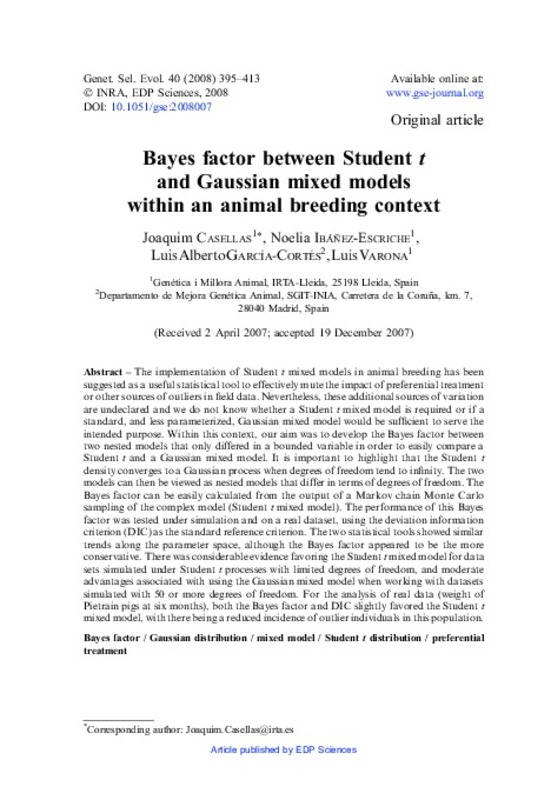JavaScript is disabled for your browser. Some features of this site may not work without it.
Buscar en RiuNet
Listar
Mi cuenta
Estadísticas
Ayuda RiuNet
Admin. UPV
Bayes factor between Student t and Gaussian mixed models within an animal breeding context
Mostrar el registro sencillo del ítem
Ficheros en el ítem
| dc.contributor.author | Casellas, J.
|
es_ES |
| dc.contributor.author | Ibáñez-Escriche, Noelia
|
es_ES |
| dc.contributor.author | Garcia-Cortes, L.A.
|
es_ES |
| dc.contributor.author | Varona, L.
|
es_ES |
| dc.date.accessioned | 2020-09-19T03:34:59Z | |
| dc.date.available | 2020-09-19T03:34:59Z | |
| dc.date.issued | 2008-07-15 | es_ES |
| dc.identifier.issn | 0999-193X | es_ES |
| dc.identifier.uri | http://hdl.handle.net/10251/150458 | |
| dc.description.abstract | [EN] The implementation of Student t mixed models in animal breeding has been suggested as a useful statistical tool to effectively mute the impact of preferential treatment or other sources of outliers in field data. Nevertheless, these additional sources of variation are undeclared and we do not know whether a Student t mixed model is required or if a standard, and less parameterized, Gaussian mixed model would be sufficient to serve the intended purpose. Within this context, our aim was to develop the Bayes factor between two nested models that only differed in a bounded variable in order to easily compare a Student t and a Gaussian mixed model. It is important to highlight that the Student t density converges to a Gaussian process when degrees of freedom tend to infinity. The two models can then be viewed as nested models that differ in terms of degrees of freedom. The Bayes factor can be easily calculated from the output of a Markov chain Monte Carlo sampling of the complex model (Student t mixed model). The performance of this Bayes factor was tested under simulation and on a real dataset, using the deviation information criterion (DIC) as the standard reference criterion. The two statistical tools showed similar trends along the parameter space, although the Bayes factor appeared to be the more conservative. There was considerable evidence favoring the Student t mixed model for data sets simulated under Student t processes with limited degrees of freedom, and moderate advantages associated with using the Gaussian mixed model when working with datasets simulated with 50 or more degrees of freedom. For the analysis of real data (weight of Pietrain pigs at six months), both the Bayes factor and DIC slightly favored the Student t mixed model, with there being a reduced incidence of outlier individuals in this population. | es_ES |
| dc.description.sponsorship | The authors are indebted to Dr. J.L. Noguera and COPAGA for field data on pig weight at six months, and to Dr. J. Piedrafita and Dr. G. Caja for providingadditional field data sets during preliminary tests of the Bayes factor. The research contract of J. Casellas was partially financed by Spain s Ministerio de Educación y Ciencia (Programa Juan de la Cierva). | es_ES |
| dc.language | Inglés | es_ES |
| dc.publisher | Springer (Biomed Central Ltd.) | es_ES |
| dc.relation.ispartof | Genetics Selection Evolution | es_ES |
| dc.rights | Reconocimiento (by) | es_ES |
| dc.subject | Bayes factor | es_ES |
| dc.subject | Gaussian distribution | es_ES |
| dc.subject | Mixed model | es_ES |
| dc.subject | Student t distribution | es_ES |
| dc.subject | Preferential treatment | es_ES |
| dc.subject.classification | PRODUCCION ANIMAL | es_ES |
| dc.title | Bayes factor between Student t and Gaussian mixed models within an animal breeding context | es_ES |
| dc.type | Artículo | es_ES |
| dc.identifier.doi | 10.1051/gse:2008007 | es_ES |
| dc.rights.accessRights | Abierto | es_ES |
| dc.contributor.affiliation | Universitat Politècnica de València. Departamento de Ciencia Animal - Departament de Ciència Animal | es_ES |
| dc.description.bibliographicCitation | Casellas, J.; Ibáñez-Escriche, N.; Garcia-Cortes, L.; Varona, L. (2008). Bayes factor between Student t and Gaussian mixed models within an animal breeding context. Genetics Selection Evolution. 40(4):395-413. https://doi.org/10.1051/gse:2008007 | es_ES |
| dc.description.accrualMethod | S | es_ES |
| dc.relation.publisherversion | https://doi.org/10.1051/gse:2008007 | es_ES |
| dc.description.upvformatpinicio | 395 | es_ES |
| dc.description.upvformatpfin | 413 | es_ES |
| dc.type.version | info:eu-repo/semantics/publishedVersion | es_ES |
| dc.description.volume | 40 | es_ES |
| dc.description.issue | 4 | es_ES |
| dc.identifier.pmid | 18558073 | es_ES |
| dc.identifier.pmcid | PMC2674909 | es_ES |
| dc.relation.pasarela | S\392555 | es_ES |
| dc.contributor.funder | Ministerio de Educación y Ciencia | es_ES |








